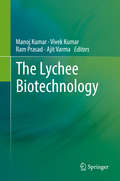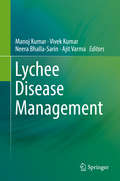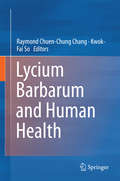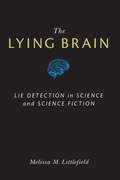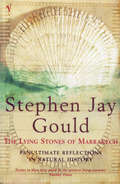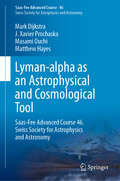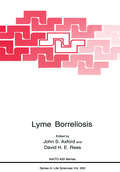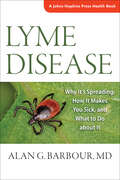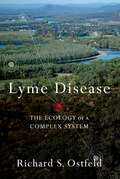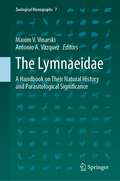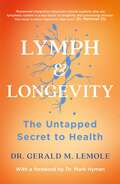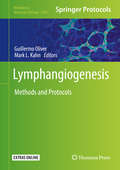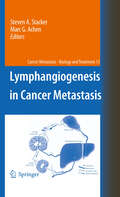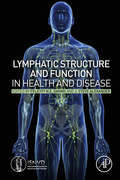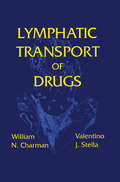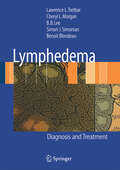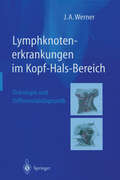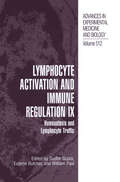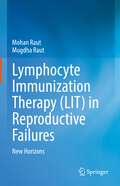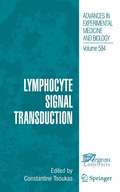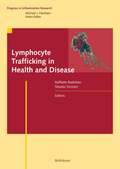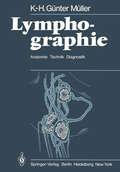- Table View
- List View
The Lychee Biotechnology
by Manoj Kumar Vivek Kumar Ram Prasad Ajit VarmaThis book provides systematic information on the lychee and modern tools to promote its sustainable growth and development. Including dedicated chapters on the evolution and diversification of the lychee, it highlights its genetic makeup and reciprocal exogenous factors, addressing the narrow genetic pool and lack of natural biodiversity. It also discusses issues related to post-harvest losses and robust approaches at the commercial level. Further, the book offers insights on in vitro propagation methods and prospective transgenic approaches for selected lychee cultivars. Chapters on the production of bioactive compounds and their enhancement through genetic transformation and elicitation are also included, reflecting the latest advances in the field of lychee biotechnology. Lastly, the book explores the use of molecular marker techniques to achieve the desired improvements in fruit trees’ medicinal and aesthetic value.
Lychee Disease Management
by Manoj Kumar Vivek Kumar Neera Bhalla-Sarin Ajit VarmaThis book offers a comprehensive compilation of biotic and abiotic factors that affect lychee production and commercialization. It addresses disease management for a range of causal agents, including the leaf mite (Acerya litchi Keifer), leaf miner (Conopomorpha cramerella), fruit borers (Conopomorpha cramerella, Platypeplus aprobola Meyer and Dichocrosis sp.), leaf webber / roller (Platypepla aprobola Meyer), litchi bug (Tessarotoma javanica Thunb), bark-eating caterpillar (Indarbela quadrinotata) and shoot borer (Chlumetia transversa), etc.Specialized chapters highlight potential approaches to optimizing and increasing the scope of lychee export, as well as systematic research on the development and refinement of technologies for enhancing lychee productivity and quality. Further aspects addressed include post-harvest handling, processing and value addition, the development of tolerant varieties, high yield and processing. As such, ‘Lychee Disease Management’ offers a valuable resource dedicated to the global agriculture community, which is currently facing considerable production and commercialization problems.
Lycium Barbarum and Human Health
by Raymond Chuen-Chung Chang Kwok-Fai SoThis book seeks to unravel the mysteries of wolfberry, and systematically introduces its mechanisms in preventing aging-associated diseases, such as cardiovascular diseases, inflammation, liver and neurodegenerative diseases. Wolfberry, the dried fruit of Lycium barbarum, is an anti-aging herbal medicine. There have been numerous reports investigating the underlying mechanisms of its anti-aging effects and its role in preventing pathological changes in many aging-associated diseases. Its holistic effects on the body can attenuate liver toxicity and combat the spread of cancer; it also prevents degeneration in the central nervous system, and can even positively affect the skin. As such, wolfberry has become a very popular food supplement around the world. This book will serve as an excellent reference source for researchers and graduate students studying herbal medicine and aging-associated diseases, while also providing insights for the pharmaceutical industry with regard to developing potential drugs for these diseases.
The Lying Brain: Lie Detection in Science and Science Fiction
by Melissa M Littlefield"The Lying Brain is a study to take seriously. Its argument is timely, clear, and of particular importance to the enlargement of our understanding of the relationships among science studies, literary studies, and technology studies." ---Ronald Schleifer, University of Oklahoma Real and imagined machines, including mental microscopes, thought translators, and polygraphs, have long promised to detect deception in human beings. Now, via fMRI and EEG, neuroscientists seem to have found what scientists, lawyers, and law enforcement officials have sought for over a century: foolproof lie detection. But are these new lie detection technologies any different from their predecessors? The Lying Brain is the first book to explore the cultural history of an array of lie detection technologies: their ideological assumptions, the scientific and fictional literatures that create and market them, and the literacies required for their interpretation. By examining a rich archive of materials about lie detection---from science to science fiction---The Lying Brain demonstrates the interconnections of science, literature, and popular culture in the development and dissemination of deception detection in the American cultural imagination. As Melissa Littlefield demonstrates, neuroscience is not building a more accurate lie detector; it is simply recycling centuries-old ideologies about deception and its detection. Cover art: "Human Brain" © Denis Barbulet, courtesy of Shutterstock.com
The Lying Stones Of Marrakech: Penultimate Reflections in Natural History (Drakontos Ser.)
by Stephen Jay GouldStephen Jay Gould's writing remains the modern standard by which popular science writing is judged. Ever since the late 1970s up until till his death in 2002, his monthly essay in Natural History and his full-length books bridged the yawning gap between science and wider culture.In this fascinating new collection of essays from Natural History, Gould applied biographical perspectives to the illumination of key scientific concepts and their history, ranging from the origins of palaeontology to modern eugenics and genetic engineering. The essays brilliantly illuminate and elucidate the puzzles and paradoxes great and small that have fuelled the enterprise of science and opened our eyes to a world of unexpected wonders.
Lyman-alpha as an Astrophysical and Cosmological Tool: Saas-Fee Advanced Course 46. Swiss Society for Astrophysics and Astronomy (Saas-Fee Advanced Course #46)
by Matthew Hayes Mark Dijkstra J. Xavier Prochaska Masami OuchiThe hydrogen Lyman-alpha line is of utmost importance to many fields of astrophysics. This UV line being conveniently redshifted with distance to the visible and even near infrared wavelength ranges, it is observable from the ground, and provides the main observational window on the formation and evolution of high redshift galaxies. Absorbing systems that would otherwise go unnoticed are revealed through the Lyman-alpha forest, Lyman-limit, and damped Lyman-alpha systems, tracing the distribution of baryonic matter on large scales, and its chemical enrichment.We are living an exciting epoch with the advent of new instruments and facilities, on board of satellites and on the ground. Wide field and very sensitive integral field spectrographs are becoming available on the ground, such as MUSE at the ESO VLT. The giant E-ELT and TMT telescopes will foster a quantum leap in sensitivity and both spatial and spectroscopic resolution, to the point of being able, perhaps, to measure directly the acceleration of the Hubble flow. In space, the JWST will open new possibilities to study the Lyman-alpha emission of primordial galaxies in the near infrared. As long as the Hubble Space Telescope will remain available, the UV-restframe properties of nearby galaxies will be accessible to our knowledge. Therefore, this Saas-Fee course appears very timely and should meet the interest of many young researchers.
Lyme Borreliosis (Nato Science Series A: #260)
by John S. Axford David H. E. ReesLyme Borreliosis is a worldwide infectious disease causing a multisystem illness with considerable morbidity, particularly in North America and Europe. The causative agent is the spirochaete Borrelia burgdorferi, which is usually transmitted by the ixodid tick from animal reservoirs. This book is formed by contributions from the Second European Symposium on Lyme Borreliosis, held at St George's Hospital Medical School, London in 1993, which reviewed the current state of knowledge of the condition with regard to clinical manifestations, diagnosis, treatment, ecology, epidemiology, biology and immunopathogenesis. In this book, important data is reviewed concerning the clinical manifestations of Lyme Borreliosis. It seems that strain variation of the spirochaete is the main cause of regional differences seen in the clinical presentation of patients. One striking example of this, is the relatively high incidence of Lyme arthritis in the USA and apparent rarity of this manifestion in some areas of Europe. These important studies open the way for exciting new research that focuses on the immunological and molecular mechanisms that result in disease. A full insight into the ecology of Borrelia burgdorferi is essential to a balanced understanding of the disease and a number of excellent reviews on this subject are included. Significant advances with regard to the biology of Borrelia burgdorjeri and the immunopathogenic mechanisms that result in disease have been made, enabling the role of the Band T lymphocytes in disease to be established and the development of sophisticated phenotyping methods, improved diagnostic tests and effective vaccines.
Lyme Disease: Why It’s Spreading, How It Makes You Sick, and What to Do about It (A Johns Hopkins Press Health Book)
by Alan G. BarbourOnce restricted to small forested areas in the northeast and north-central United States, Lyme disease is now a common infection in North America and Europe. The Centers for Disease Control and Prevention estimate that more than 300,000 new cases occur each year in the United States. Misunderstandings over symptoms and treatment increase the public's concerns about the disease�which, if not properly treated, can become chronic and debilitating. An expert on tick-borne diseases, Alan G. Barbour explains the course of illness that results from infection, diagnosis and treatment options, and steps that can be taken to avoid a tick bite in the first place. The ticks that transmit Lyme disease may also transmit other disease-causing pathogens, and these other infections are considered as well. Drawing on real case histories of individuals with Lyme disease�or illnesses that may be mistaken for Lyme disease�Barbour explains: The biology of the spirochete, Borrelia burgdorferi, that causes Lyme disease The role of animals such as mice that carry the infection The life cycle of the ticks that transmit the infection The importance of deer in perpetuating the cycle The basics of diagnostic laboratory tests and how test results are interpreted How antibiotics are used in treating Lyme diseaseInfected ticks are abundant in the woods, in walking trails, and in the shrubs and tall grass where suburban lawns meet wooded areas. Barbour stresses preventing disease through community-wide ecology projects and individual and household protection. While it may be difficult to escape infection, understanding the danger, the symptoms, and the treatment goes a long way toward preventing long-term health consequences. Featuring a list of reliable web sites and a glossary of terms, Lyme Disease is an invaluable resource for everyone who is at risk of the disease or is involved in preventing and treating it.
Lyme Disease: The Ecology of a Complex System
by Richard OstfeldMost human diseases come from nature, from pathogens that live and breed in non-human animals and are "accidentally" transmitted to us. Human illness is only the culmination of a complex series of interactions among species in their natural habitats. To avoid exposure to these pathogens, we must understand which species are involved, what regulates their abundance, and how they interact. Lyme disease affects the lives of millions of people in the US, Europe, and Asia. It is the most frequently reported vector-borne disease in the United States; About 20,000 cases have been reported each year over the past five years, and tens of thousands more go unrecognized and unreported. Despite the epidemiological importance of understanding variable LD risk, such pursuit has been slow, indirect, and only partially successful, due in part to an overemphasis on identifying the small subset of 'key players' that contribute to Lyme disease risk, as well as a general misunderstanding of effective treatment options. This controversial book is a comprehensive, synthetic review of research on the ecology of Lyme disease in North America. It describes how humans get sick, why some years and places are so risky and others not. It challenges dogma - for instance, that risk is closely tied to the abundance of deer - and replaces it with a new understanding that embraces the complexity of species and their interactions. It describes why the place where Lyme disease emerged - coastal New England - set researchers on mistaken pathways. It shows how tiny acorns have enormous impacts on our probability of getting sick, why biodiversity is good for our health, why living next to a small woodlot is dangerous, and why Lyme disease is an excellent model system for understanding many other human and animal diseases. Intended for an audience of professional and student ecologists, epidemiologists, and other health scientists, it is written in an informal style accessible also to non-scientists interested in human health and conservation.
Lyme Disease: The Ecology of a Complex System
by Richard OstfeldMost human diseases come from nature, from pathogens that live and breed in non-human animals and are "accidentally" transmitted to us. Human illness is only the culmination of a complex series of interactions among species in their natural habitats. To avoid exposure to these pathogens, we must understand which species are involved, what regulates their abundance, and how they interact. Lyme disease affects the lives of millions of people in the US, Europe, and Asia. It is the most frequently reported vector-borne disease in the United States; About 20,000 cases have been reported each year over the past five years, and tens of thousands more go unrecognized and unreported. Despite the epidemiological importance of understanding variable LD risk, such pursuit has been slow, indirect, and only partially successful, due in part to an overemphasis on identifying the small subset of 'key players' that contribute to Lyme disease risk, as well as a general misunderstanding of effective treatment options. This controversial book is a comprehensive, synthetic review of research on the ecology of Lyme disease in North America. It describes how humans get sick, why some years and places are so risky and others not. It challenges dogma - for instance, that risk is closely tied to the abundance of deer - and replaces it with a new understanding that embraces the complexity of species and their interactions. It describes why the place where Lyme disease emerged - coastal New England - set researchers on mistaken pathways. It shows how tiny acorns have enormous impacts on our probability of getting sick, why biodiversity is good for our health, why living next to a small woodlot is dangerous, and why Lyme disease is an excellent model system for understanding many other human and animal diseases. Intended for an audience of professional and student ecologists, epidemiologists, and other health scientists, it is written in an informal style accessible also to non-scientists interested in human health and conservation.
The Lymnaeidae: A Handbook on Their Natural History and Parasitological Significance (Zoological Monographs #7)
by Maxim V. Vinarski Antonio A. VázquezThe Lymnaeidae (also known as ‘pond snails’) are a species-rich and globally distributed family of freshwater snails, many species of which are known to be hosts of parasitic trematodes (such as the liver fluke, Fasciola hepatica). Written by world-leading experts in the field, this book covers a wealth of topics ranging from the phylogeny and taxonomy of lymnaeid snails to their relationships with helminths and their impact on public and veterinary health. It provides an overview of the species richness, evolution, ecology, biogeography and fossil record of the family. A considerable number of chapters are devoted to the economic and medical importance of lymnaeids, their involvement in the transmission of fascioliasis and other zoonotic diseases. Special chapters deal with the molecular and morphological identification of the Lymnaeidae, their rearing in the laboratory and experimental approaches to their study. This contributed volume is aimed at experts and practitioners in various disciplines: Invertebrate zoology, evolutionary biology, biogeography, aquatic ecology, parasitology, epidemiology and public health. It is also useful for university lecturers, undergraduate and postgraduate students.
LYMPH & LONGEVITY: The Untapped Secret to Health
by Dr Gerald M LemoleThe lymphatic system has been one of the most misunderstood systems in our bodies. Until now.Cardiothoracic surgeon Dr. Gerald M. Lemole explains why a healthy lymphatic flow aids our bodies in reducing toxins that contribute to disease and injury. In ten short chapters, Dr. Lemole demystifies the lymphatic system, describes how powerful it is and shows how to maintain a healthy lymph system to combat specific diseases and health problems - from heart disease to cognitive function to weight management.Featuring sidebars with charts and graphs that illustrate basic principles, Lymph & Longevity also includes menus, recipes and information on supplements, as well as basic yoga and meditation guides.Illuminating, informative, and practical this essential guide is timelier now than ever as we continue to work to protect ourselves and our communities against COVID-19 and other viruses.
Lymphangiogenesis: Methods and Protocols (Methods in Molecular Biology #1846)
by Guillermo Oliver Mark L. KahnThis volume discusses the latest tools, techniques, and animal models designed to study the processes of lymphatic vascular formation in vivo and in vitro and its functions in health and disease. The chapters in the book cover topics such as genetics lineage tracing of lymphatic endothelial cells in mice; characterization of zebrafish facial lymphatics; imaging lymphatics in mouse lungs; effects of fluid shear stress of lymphatic endothelial cells; and single cell mRNA sequencing of the mouse brain vasculature. Written in the highly successful Methods in Molecular Biology series format, chapters include introductions to their respective topics, lists of the necessary materials and reagents, step-by-step, readily reproducible laboratory protocols, and tips on troubleshooting and avoiding known pitfalls.Cutting-edge and comprehensive, Lymphangiogenesis: Methods and Protocols is a valuable resource to aid researchers with applying new approaches to answer their questions in this developing field.
Lymphangiogenesis in Cancer Metastasis (Cancer Metastasis - Biology and Treatment #13)
by Steven A. Stacker Marc G. AchenLymphangiogenesis and Cancer Metastasis introduces the new field of lymphatic vessel growth and development, and its relationship to the metastatic spread of cancer cells. The book covers all aspects of this new field from the fundamental role that protein growth factors and their receptors play in lymphangiogenesis to the potential application of these advances to cancer diagnosis and treatment. Other clinical aspects explored include the mechanisms and importance of lymph node metastasis, the role of the lymphatics in lymphangioleiomyomatosis and Kaposi’s sarcoma, and approaches for imaging lymphatics in cancer. The book also covers the innovative approaches taken by researchers to explore new roles for lymphatic vessel biology in the context of cancer. The information presented in this volume, which describes the revolutionary concepts of tumor lymphangiogenesis, will be of interest to all students, scientists and oncologists who are seeking to understand the complexities of tumor metastasis. Key Features: Presents fundamental concepts of tumor lymphangiogenesis and the molecules which control this process Provides a comprehensive summary of current research in this ground breaking area Provides a book which links progress in basic tumor and developmental biology with current and future oncology practise Is an essential text for molecular biologists, cell biologists and oncologists seeking to understand the implications of this rapidly developing area.
Lymphatic Structure and Function in Health and Disease
by Felicity N.E. Gavins J. Steve AlexanderLymphatic Structure and Function in Health and Disease serves as a resource book on what has been learned about lymphatic structure, function and anatomy within different organ systems. This is the first book to bring together lymphatic medicine as a whole, with in-depth analysis of specific aspects of lymphatics in different vascular pathologies. This book is a useful tool for scientists, practicing clinicians and residents, in particular, those in vascular biology, neurology, cardiology and general medicine. Chapters discuss topics such as ontogeny and phylogeny of lymphatics, lymphatic pumping, CNS lymphatics, lymphatics in transplant and lymphatic reconstruction.Brings together lymphatic medicine as a whole, with an in-depth analysis of the specific basic science aspects of lymphatic structure and functionCovers the clinical aspects of lymphatics in different vascular pathologiesCo-published with the International Society of Neurovascular DiseasesDiscusses lymphatic structure and function in all of the major organ systems
Lymphatic Transport of Drugs
by William N. CharmanLymphatic Transport of Drugs provides a thorough review of the determinants that affect the uptake and delivery of drugs and xenobiotics to the lymphatics. Factors affecting the transport and delivery of lipophilic drugs through the lymph after oral administration, lymphatic transport of polar drugs and macromolecules after gastrointestinal dosing, transport of drugs into the lymph after parenteral administration, and particulate drug delivery systems are among the topics examined in this volume. Lymphatic Transport of Drugs is primarily intended for pharmaceutical scientists who are attempting to alter the delivery of current therapeutic agents through formulation of prodrugs, as well as for researchers designing new drugs for lymph delivery.
Lymphatic Transport of Drugs
by William N. CharmanLymphatic Transport of Drugs provides a thorough review of the determinants that affect the uptake and delivery of drugs and xenobiotics to the lymphatics. Factors affecting the transport and delivery of lipophilic drugs through the lymph after oral administration, lymphatic transport of polar drugs and macromolecules after gastrointestinal dosing, transport of drugs into the lymph after parenteral administration, and particulate drug delivery systems are among the topics examined in this volume. Lymphatic Transport of Drugs is primarily intended for pharmaceutical scientists who are attempting to alter the delivery of current therapeutic agents through formulation of prodrugs, as well as for researchers designing new drugs for lymph delivery.
Lymphedema: Diagnosis and Treatment
by Lawrence L Tretbar Cheryl L. Morgan Byung-Boong Lee Simon J. Simonian Benoit BlondeauA comprehensive, evidence-based introduction to the area of lymphology, the book is directed mainly to the US audience and will appeal to an interdisciplinary field of health professionals. It describes the unique anatomy and physiology of the lymphatic system and the intimate relationship it shares with the venous system. It explores the differential diagnosis of the "swollen leg/arm", which is often the presenting problem to the health care professional. The necessity of history taking, physical examination and laboratory studies are noted. Treatment methods are described as an introduction and psychosocial and quality of life issues are explored in depth.
Lymphknotenerkrankungen im Kopf-Hals-Bereich: Onkologie und Differenzialdiagnostik
by Jochen A. WernerEntscheidendes rechtzeitig erkennen! Umfassender Überblick über die Vielfalt der Lymphknoten-Erkrankungen - Differentialdiagnose und Therapie mit Indikation zur Strahlentherapie - Klare Didaktik, hervorragende Abbildungen - Schwerpunkt: Die lymphogene Metastasierung von Plattenepithelkarzinomen Mit diesem Nachschlagewerk bringen Sie Ihr Wissen ein entscheidendes Stück weiter.
Lymphocyte Activation and Immune Regulation IX: Homeostasis and Lymphocyte Traffic (Advances in Experimental Medicine and Biology #512)
by WilliamPaul EugeneButcher SudhirGuptaThis volume is divided into three sections. Section I deals with factors that regulate the development and maturation of T cells and B cells and lymphocyte traffic. The significance of C-kit, Bcl-6, IL-7, and Vav in the development of T and B lymphocytes is discussed. A role of lymphotoxins and VAP-I in trafficking of leucocytes is reviewed. Finally, the trafficking and homing characteristics of T cell and B cell subsets, and the regulation of these processes during the immune response, is presented. Section II discusses various aspects of naive and memory T cell biology, including clonal expansion, reprogramming of genes including those encoding cytokines and cytotoxic granules, changes in the expression of cell surface proteins involved in cell-cell adhesion, homing of naive and memory T cells, the role of MHC and cytokines in the maintenance of naive and memory T cells, and the characterization and differentiation of virus-specific memory T cell heterogeneity in mice and humans. Novel methods of visualization of immune cells and immune systems are reviewed in Section III.
Lymphocyte Antibodies (tactile)
by RnibThis diagram shows the three-part process whereby lymphocyte cells in the blood release antibodies, to clamp bacteria together so that it can be ingested by phagocyte cells. Arrows are used to move the reader through the diagram, with different textures to show bacteria and blood cells.
Lymphocyte Immunization Therapy (LIT) in Reproductive Failures: New Horizons
by Mohan Raut Mugdha RautRecurrent Miscarriages (RM) & Implantation Failure (IF) have remained an enigma to clinicians and researchers. Even after ruling out all possible causative factors, 50-60% cases still remain “Unexplained’. A majority of these so called “Unexplained” cases are now found to have immunological basis.This book is going into the Immunological aspects of these clinical dilemmas, demystifying the role of Immunology and Immunotherapy in RM and IF. The authors have been working in the field of Reproductive Immunology and Immunotherapy for the last 25 years and they have come out with this book combining the international studies with their own experience. The purpose of writing this book is to provide a comprehensive treatise about Immunotherapy, so that it can become an acceptable modality of treatment in cases where it is needed and is effective.The book discusses the basics in Reproductive Immunology. The immunological changes occurring during pregnancy, the role of Cell mediated Immunity (T cells), Humoral Immunity including cytokines is explained. The normal immunological mechanisms protecting the embryo are highlighted and how these mechanisms are disturbed leading to RM and IF, is also explained.The first and the most discussed method of Immunotherapy is Lymphocyte Immunization Therapy (LIT). The book has given a complete overview of LIT, describing how it created euphoria when it was first introduced, how it gradually went into disrepute and how it is now making a comeback. As the authors have personal experience of LIT, the book gives a detailed and complete information about this active form of immunotherapy.The book has a special section on case studies where the authors have given some clinical case reports (including some of their own), who were treated for immunological factor in RM/IF and were treated with Immunotherapy. These cases can be a useful guide to the readers.The book will be useful not only for undergraduate and postgraduate students but also for clinicians in their practice and for researchers for review of developments in the field.
Lymphocyte Signal Transduction
by Constantine TsoukasThis is the third workshop on this topic that took place in Crete from May 27 to June 1, 2005. Similar to the two previous workshops, held in Santorini October 2000 and 2002 respectively, the purpose of this workshop is to bring together scientists from all over the world to discuss their latest findings on the various aspects of lymphocyte signal transduction. The participants represented academia, industry, foundation and governmental laboratories.
Lymphocyte Trafficking in Health and Disease (Progress in Inflammation Research)
by Raffaele Badolato Silvano SozzaniThis book deals with the description of the role of chemokines in immune response and underlines potential targets of therapeutical intervention. It offers a series of international contributions of the most challenging aspects of lymphocyte migration in homeostasis and in disease, and has a special focus on diseases and targets of therapeutical intervention. The book will interest researchers and clinicians from inflammation research.
